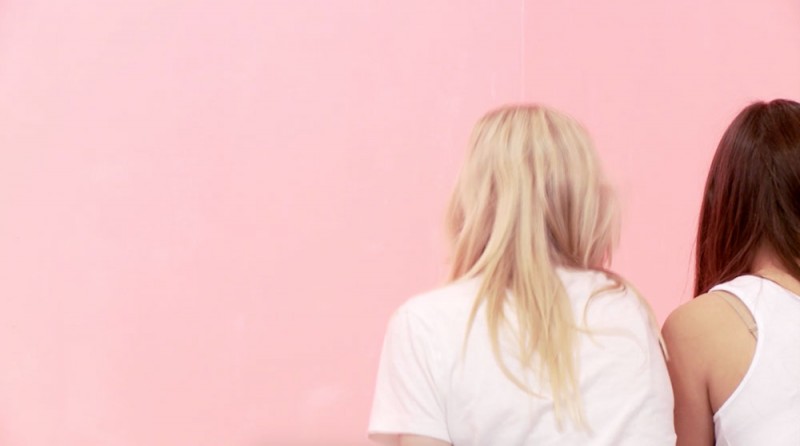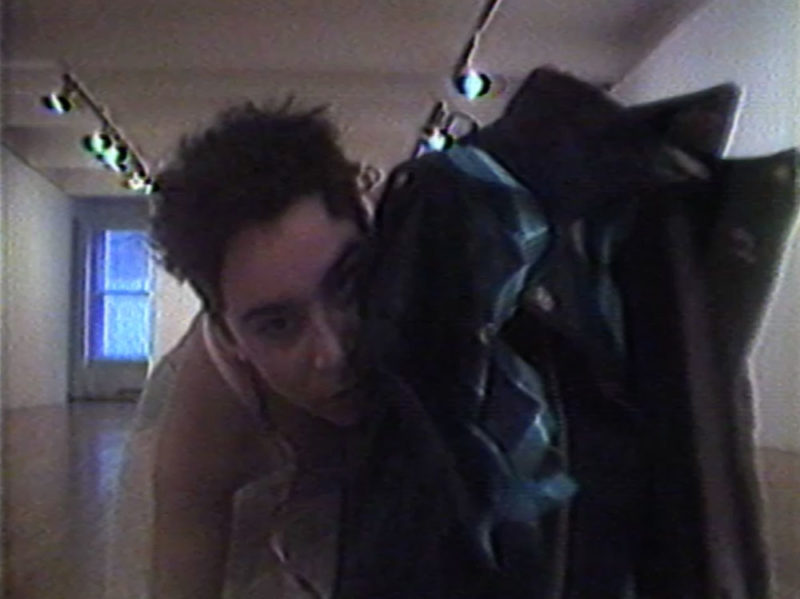SHOOT YOURSELF
March 5th – March 11th
With work by Armin Heurich, Anna Chiaretta Lavatelli, Ellen Spiro, and Studio of the Streets (Tony Conrad, Cathleen Steffan, Ann Szyjka)
As part of Squeaky@x0
Andy Warhol’s adage that “Everyone will be famous for 15 minutes” was already well-worn in the 1980s when Squeaky Wheel was founded. While his promise of embodiment was certainly prophetic, agency was never part of that deal, our bodies at the whim of industry. This lack of representation often led artists to turn the cameras on themselves, and the works gathered this week ruminate on the possibilities of the gaze met, returned, refused.
Between 1990-1994, Squeaky Wheel founder Tony Conrad, along with Cathleen Steffan, and Ann Szyjka produced Studio of the Streets, a cable access show where the artists would interview people in front of city hall in Buffalo. In an interview with Film Comment, Conrad talked about his role in Studio of the Streets, along with his changing practice in the 80s, stating:
This was at a point when I had moved in the direction of a conception of myself more as an ‘animator,’ rather than an artist or director. By animator I mean a person who ‘animates’ the activities or productive work of another person rather than egoistically foregrounding his own work and presence in a particular social situation. The idea of becoming an animator rather than an artist or director, for me, rose out of the critical environment in the Seventies that had to do with issues of identity politics. I increasingly understood that being a white, American, middle-class, male, heterosexual, etc., positioned me in a way that identified me, automatically and without critical review, as ‘part of the problem rather than part of the answer’ and it might be appropriate for me to devote my attention to the concerns of adequate representation among subaltern people.¹
While Tony is often on camera, the word animator is precise: he is goofy, likable, and very much plays the fool to let others be comfortable talking about their lives in front of a camera, an object of intimidation as much as it is of control.
Armin Heurich’s Last Rites directly takes on this controlling figure by meeting it heads on, asking it questions from a cautionary German children’s book from the 1980s. Ellen Sprio’s Private Domain, made a year apart from Heurich’s piece, is more direct in its critique. As Spiro has the camera follow her gaze, captions appear on the screen: “We who have been excluded from making television must claim the tools as our own” and “Authority is gained by obtaining technical information which is part of an elite domain.” Over and over, Spiro on the soundtrack exclaims “Here I am, in the domain of technical pleasure.”
This pleasure is then directly confronted in Anna Lavatelli’s The Pink Room: 3 and the in-between. Presented as a projection, a single channel excerpt from a series of videos, The Pink Room’s gnarly versions of pop songs fill the room, with Lavatelli’s piece focusing on two young women over a pink backdrop, as they seem locked by an unseen presence: in this case the eyes of the viewer. If the other pieces in this week’s exhibition challenge the gaze and its industry by meeting it head on, Lavatelli’s piece examines the effects of an unchecked gaze, an eye that attempts to control as it does to mold, as the actresses refuse the conditions of their confinement. – Ekrem Serdar
¹ Yue, Genevieve. “Loose Ends: An Interview with Tony Conrad” Film Comment. 11 Oct. 2012. Web. 02 Mar. 2016.
Work Descriptions

The Pink Room: 3 and the in-between (single channel excerpts)
Anna Chiaretta Lavatelli
7min, HD Digital Video, USA, 2011
They were fixed by a gaze, isolated and animated by the attention they received. Power operated as a mechanism of attraction; it drew out the peculiarities over which it kept watch. Pleasure spread to the power that harried it; power anchored the pleasure it uncovered. —Michel Foucault, The History of Sexuality
The pleasure of power, and the power of pleasure, but what if there is no pleasure? The girls are fixed by a gaze they perceive to be fixed upon them; this is their supposed pleasure? The visual culture that surrounds adolescent girls poses the location of pleasure as being that which is consumed by the gaze. To be looked at, particularly to look good enough to be looked at, is pleasure.
The suite of videos created for The Pink Room was the result of 6 months of video created in collaboration with two young actresses, the resulting videos were conceived originally as an installation composed inside of an oppressive spacial installation. The space oppressed the viewer so that by the time they were confronted with the images of the girls, the viewer would find empathy, or at the least discomfort in viewing the young subjects, creating tension with the cultural standard of objectifying their sexuality. Yet the images only perform in context of the viewer watching, as it is with this uncomfortable gaze that the content is activated.

Private Domain
Ellen Spiro
6 min, ¾ U-Matic Video to Digital Video, USA, 1988
In Ellen Sprio’s Private Domain, the camera tracks her gaze while Spiro repeatedly exclaims “Here I am, in the domain of technical pleasure.” Captions appear on the screen challenging conventions of industry and agency: “We who have been excluded from making television must claim the tools as our own” and “Authority is gained by obtaining technical information which is part of an elite domain.”

LAST RITES
Armin Heurich
2min, ¾ U-Matic Video to Digital Video, USA, 1987
Last Rites was initially a component of a performance piece (Hallwalls, 1987) exploring cultural roots of patriarchy and fascism from a deeply personal perspective. The performance was framed by images and text from Die Struwwelpeter (Shockheaded Peter) by Heinrich Hoffman, published in 1845 as an enormously popular children’s book filled with cautionary tales about the potentially disastrous consequences of misbehavior and moral failings. These horrifying, graphic illustrations of children having their digits chopped off for thumb sucking, dying of malnutrition because they didn’t eat their soup, or being mocked and injured for daydreaming or practicing selfish behavior were likely seared into the memory of every German. (It was translated into English by Mark Twain.) The dizzying swish-pans and relentless questioning was intended to function as a disorienting role-play, evoking a child’s reaction to a parent’s combativeness.

Studio of the Streets
Tony Conrad & Cathleen Steffan
60 min, ¾ U-Matic Video to Digital Video, USA, 1991
From 1990–1993, the Studio of the Streets crew turned the street into a studio and produced over 100 videotapes containing over 250 weekly, hour-long shows in order to simultaneously protest the lack of a local public access facility in Buffalo, and the lack of platforms for independent producers and the public to respond to the mainstream media. Studio of the Streets engaged in unscripted, public dialogue every Friday “at high noon” with passersby from the steps of City Hall; and while doing so, quite literally (and rather uniquely) taught participants and viewers alternative means and methods for producing and distributing a TV show through live example. Interviews ran the gamut from casual conversation about the weather, to local and national politics, to video production and beyond. The team consisted of Tony Conrad and Cathleen Steffan, and regular Ann Szyjka, as well as many of their rather active local media making contemporaries.

